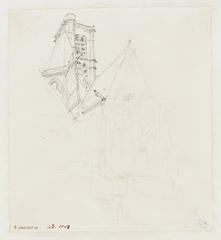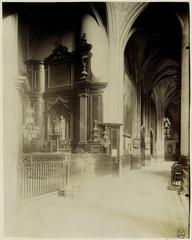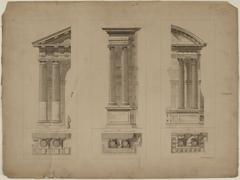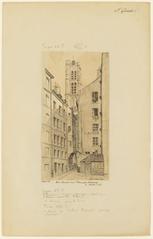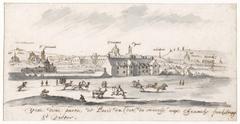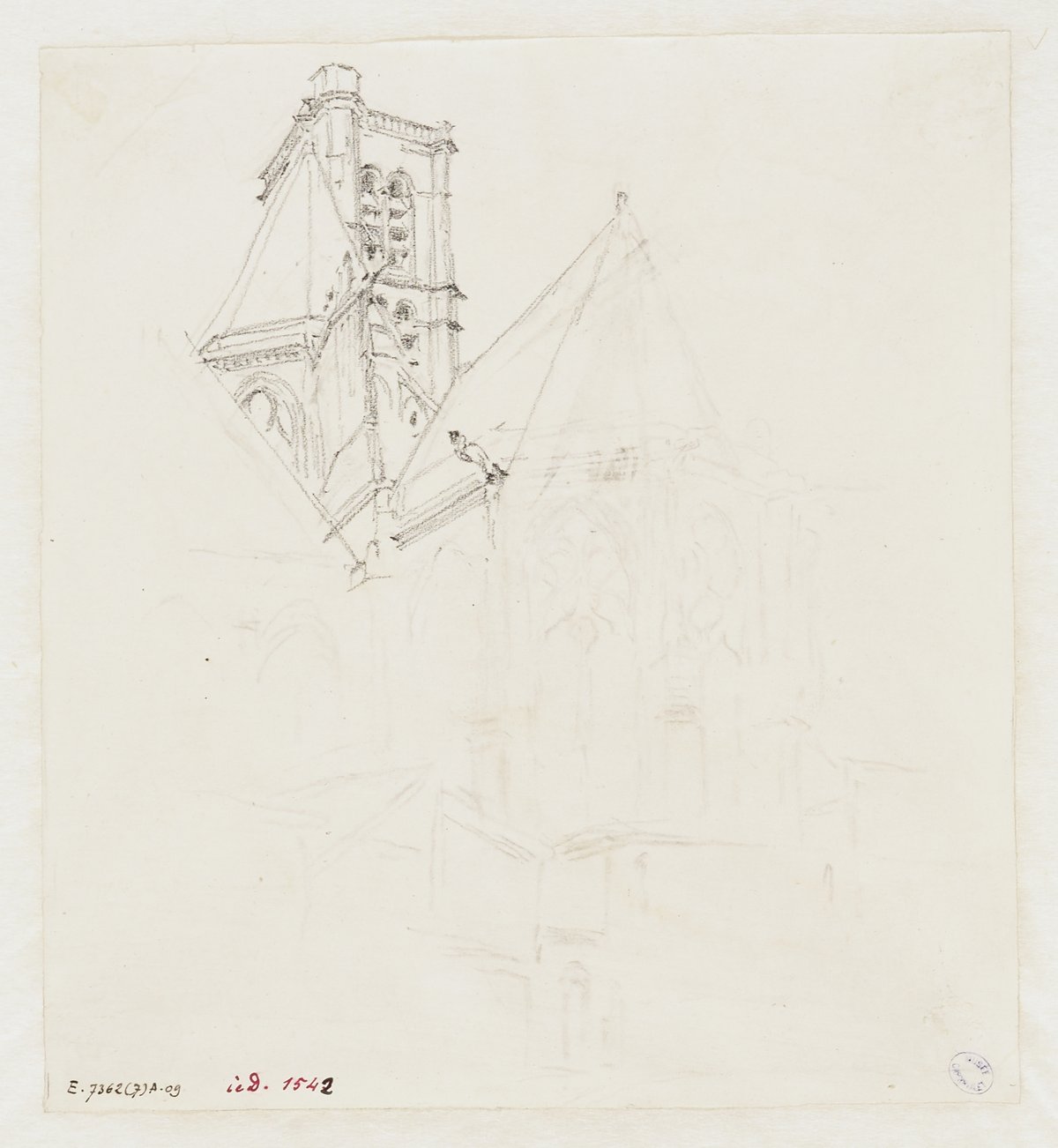
Saint-Gervais-Saint-Protais Church in Paris: Visiting Hours, Tickets, Historical & Cultural Guide
Date: 14/06/2025
Introduction
Saint-Gervais-Saint-Protais Church is a cornerstone of Paris’s religious, architectural, and musical heritage. Nestled in the historic Marais district of the 4th arrondissement, it stands as one of the oldest parish sites on the Right Bank, with roots stretching back to the 6th century. This guide provides an in-depth look at the church’s history, architectural evolution, musical traditions, and practical information—such as visiting hours, ticketing, accessibility, and nearby attractions—enabling visitors to engage fully with this remarkable Parisian landmark (Saint-Gervais-Saint-Protais Baroque Heritage, Paris Discovery Guide, Wikipedia, France-Voyage).
Historical Overview
Origins and Early Development
Saint-Gervais-Saint-Protais Church began as a modest oratory in the 6th century, dedicated to twin martyrs Gervasius and Protasius of Milan. As Paris expanded, the church evolved to serve a growing community of artisans and merchants, becoming a focal point in the bustling Marais. Its location near the Hôtel de Ville further cemented its civic and religious significance.
Architectural Evolution
Medieval Foundations and Gothic Expansion
From the 13th century, the church underwent significant expansion in the Flamboyant Gothic style, notable for ribbed vaults, slender columns, and luminous stained glass. Archaeological evidence reveals earlier foundations beneath the current structure, indicating centuries of rebuilding and adaptation.
Renaissance and Baroque Transformation
A major transformation occurred in the late 16th and early 17th centuries. Salomon de Brosse, renowned for the Palais du Luxembourg, designed the church’s western façade—completed in 1621—as the city’s first example of French Baroque classicism. The façade’s three classical orders (Doric, Ionic, Corinthian) set a precedent for Parisian ecclesiastical architecture (Paris Walking Guide, Sortir à Paris).
Modern Restorations and Wartime History
The church has survived tumultuous periods, including the French Revolution and World War I. In 1918, a German shell killed 91 people during a Good Friday service, a tragedy commemorated within the church. Restoration campaigns in the 19th, 20th, and 21st centuries have preserved both the building’s structure and its artistic heritage (Orgues et Vitraux).
Architectural and Artistic Highlights
- Façade: Designed by Salomon de Brosse, the tripartite façade is a landmark of early 17th-century Parisian classicism (Wikipedia).
- Interior: The soaring nave and choir reflect Flamboyant Gothic style; the Chapelle de la Vierge features a remarkable keystone and 16th-century stained glass.
- Stained Glass: Ranging from Renaissance masterpieces to contemporary works by Sylvie Gaudin and Claude Courageux.
- The Organ: The historic instrument, dating to 1601 and played by the Couperin family for over a century, is among the city’s most celebrated.
- Golden Chapel (Chapelle Dorée): A Louis XIII style chapel with gilded woodwork and Passion/Resurrection scenes, accessible during special events (France-Voyage).
Musical and Liturgical Heritage
The Couperin Legacy
From 1653 to 1826, the Couperin family served as titular organists, cementing the church’s reputation as a center of sacred music. The organ, restored with historical care, regularly hosts recitals and is renowned for its authentic sound and craftsmanship (Orgues et Vitraux, Sortir à Paris).
Choral and Liturgical Music
Since the 1970s, the Monastic Fraternities of Jerusalem have overseen the church’s spiritual life, introducing daily sung offices and Gregorian chant. Their liturgies, open to the public, are broadcast nationally and attract worshippers and music lovers.
Regular Events
- Heritage Days (Journées du Patrimoine): Guided tours, workshops, and concerts.
- Nuit Blanche: Nighttime arts festival performances.
- Organ Recitals: Frequent concerts showcasing French Baroque and contemporary repertoire.
Visiting Information
Location and Directions
- Address: 13 Rue des Barres / 10 Rue des Barres, 75004 Paris
- Access: Metro Lines 1 & 11 (Hôtel de Ville), Line 1 (Saint-Paul), and several bus routes.
Opening Hours
- General Hours: Daily, usually from 10:00 AM to 6:00 PM. Some sources also list 8:00 AM–7:00 PM. Hours may vary for services, holidays, or special events. Always check the official website for up-to-date times.
Tickets and Admission
- Entry: Free for all visitors.
- Tickets: Only required for certain concerts or guided tours; prices announced in advance.
Accessibility
- Facilities: Wheelchair accessible via ramps, accessible restrooms, and assistance available upon request.
Guided Tours and Events
- Tours: Available during special events (such as Heritage Days) and via local operators. Audio guides are sometimes provided.
- Concerts: Organ recitals and choral events are regularly scheduled; see notice boards or the official agenda for details.
Spiritual and Community Life
The Monastic Fraternities of Jerusalem
Founded in 1975, this community brings monastic life into the heart of the city, offering a daily schedule of prayer, Mass, and sung offices. Their charism centers on contemplation, simplicity, and hospitality, welcoming all who seek reflection or spiritual accompaniment. Lay fraternities also participate, fostering a diverse and inclusive community (fraternites-jerusalem.org).
Daily Liturgical Schedule (subject to change)
- Lauds: Sunday 8:00 AM
- Mass: Sunday 11:00 AM
- Vespers: Sunday 6:30 PM
- Weekday services: Check the official website for up-to-date times.
Tips for Visitors
- Combine your visit with nearby attractions: Hôtel de Ville, Place des Vosges, Picasso Museum, and the charming streets of the Marais.
- Arrive early for concerts or liturgies, as seating can be limited.
- Photography: Respect restrictions, especially during services.
- Dress code: Modest attire is advised in this sacred space.
Frequently Asked Questions (FAQ)
Q: What are the visiting hours for Saint-Gervais-Saint-Protais?
A: Generally 10:00 AM–6:00 PM daily, but always check the official website for updates.
Q: Is there an entrance fee?
A: Admission is free; donations are welcome.
Q: Are guided tours available?
A: Yes, especially during special events. Bookings and information are on the official website.
Q: Is the church wheelchair accessible?
A: Yes, with ramps and assistance as needed.
Q: Can visitors attend services and concerts?
A: Yes, all are welcome to participate in liturgies and attend public concerts.
Q: What public transport serves the church?
A: Metro Lines 1 & 11 (Hôtel de Ville), Line 1 (Saint-Paul), and bus lines 67, 69, 76.
Conclusion and Recommendations
Saint-Gervais-Saint-Protais Church is a living monument that unites history, art, music, and spirituality in the heart of Paris. From its pioneering Baroque façade and medieval origins to its world-class organ and vibrant liturgical community, the church offers a profound experience for every visitor. With free admission, accessible facilities, guided tours, and regular concerts, it is an essential stop for anyone interested in Paris’s heritage.
For the latest visiting hours, special event schedules, or to book a guided tour, visit the official parish website or consult local tourism resources. Enhance your exploration with the Audiala app for audio guides and up-to-date information.
References
- Saint-Gervais-Saint-Protais Baroque Heritage
- Paris Walking Guide
- Sortir à Paris
- Fraternities of Jerusalem
- France-Voyage
- Paris Discovery Guide
- Wikipedia
- Orgues et Vitraux
For more guides to Paris historical sites, spiritual destinations, and cultural events, explore our related articles and download the Audiala app. Follow us on social media for real-time updates and exclusive content.
